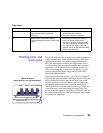58
Chapter 3: Using color
Guidelines
Follow these guidelines when using color:
• Less is better when using color. Overusing color can
minimize its impact.
• Be consistent with your color use to make your mes-
sage meaningful and easy to understand. For exam-
ple, use the same color in a document to highlight
similar concepts.
• Use the brightest color to draw attention to the most
important point.
• When adding color to a business document, use the
color for meaning and clarification, not decoration.
• Avoid colors that may offend or confuse your audi-
ence.
• In a pie chart, fill each slice with a solid color. Draw
attention to the most important slice with the
brightest color.
• When using color on transparencies, use vivid, satu-
rated colors. Use high contrast colors to attract
attention to major points.
• Select colors that look good together and reinforce
your message.
• Avoid red and green combinations. These colors are
hard for people with red/green color blindness to
distinguish.
For more information about color, refer to the numerous
books available in the marketplace and to the documenta-
tion that is included with your software application.
Defining color
Because perception of color is subjective, no two people
see color in exactly the same way. In the desktop printing
environment, how we perceive color also depends on
whether we are looking at color on a computer screen or
printed on paper.
Knowing how color is produced gives you a clearer
understanding of color and how it works with your color
printer. For example, light coming from a computer screen


















